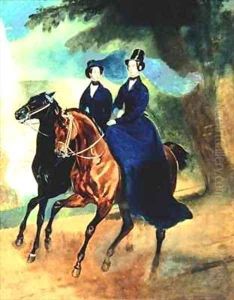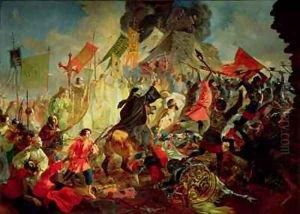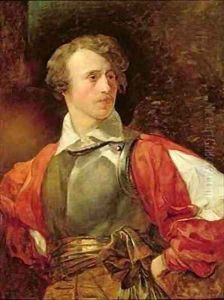Karl Pavlovich Briulloff Paintings
Karl Pavlovich Briullov, sometimes referred to as Charles Bruleau, was a Russian painter of the first half of the 19th century, renowned for his Romantic style and considered one of the greatest Russian artists of his time. Born on December 12, 1799, in St. Petersburg, he hailed from a family with French roots; his father worked as a sculptor and his grandfather was a court painter. This artistic environment deeply influenced Briullov's future path.
Briullov demonstrated artistic talent at a young age and received his education at the Imperial Academy of Arts in St. Petersburg. He excelled at the academy, winning several medals for his work. After graduating, he earned a scholarship to travel to Europe to study and work, which was a turning point in his artistic development. He spent a significant amount of time in Italy, where he was particularly influenced by the grandeur and drama of Italian Renaissance and Baroque art.
Briullov's most famous work is 'The Last Day of Pompeii,' completed in 1833, which depicts the catastrophic eruption of Mount Vesuvius in AD 79. The painting's dramatic portrayal of human despair, combined with its technical brilliance, won him international acclaim. This piece was pivotal in earning him the title of the first Russian painter to gain widespread recognition in the West. Briullov's mastery in portraying light and his ability to capture the psychological nuances of his subjects were both innovative and inspirational to his contemporaries and future generations.
Besides large historical paintings, Briullov also created portraits, genre scenes, and landscapes. His portraits, in particular, are celebrated for their elegance and the way they capture the personality and social status of the subjects. Despite his success in historical and narrative themes, it was his portraiture that provided him with a steady income.
Briullov's impact on Russian art is profound. He played a significant role in the transition from Neoclassicism to Romanticism in Russian painting, and his works influenced the next generation of Russian artists. Unfortunately, his life was cut short when he died of pneumonia on June 11, 1852, in the Italian village of Manziana. Briullov's legacy is preserved in his numerous paintings that are displayed in museums and galleries worldwide, including the Russian Museum in St. Petersburg and the Tretyakov Gallery in Moscow.


